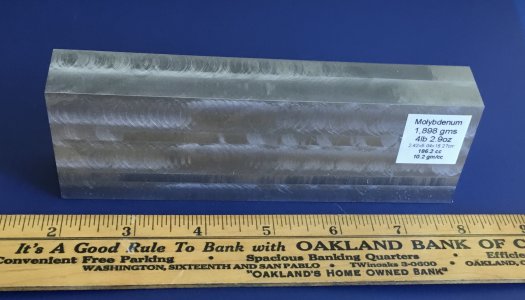- Joined
- May 16, 2016
- Messages
- 1,704
I have a small 1x2x6 metal collection. See snapshot.
It is really quite interesting how different these materials are. Copper has an incredible color. Tungsten makes lead feel light. Magnesium makes aluminum feel heavy. Titanium feels warm (5% of the thermal conductivity of copper). Bismuth has very sparkly crystal planes. I have managed to find inexpensive off-pieces--can't afford commercial prices.
There are many more safe elements that in principle are affordable.
What is a challenge is finding large enough pieces that I can mill down to 1x2x6. Zinc and Lead I was was able to melt myself. Tin and Bismuth I have the material, but need still to melt them (given they are more expensive materials I want to do so with less waste than the bread pan molds I have been using. But I'll get these done in a month or two.)
At times I come across an affordable source of the material, but it is in too small of a form factor. For some of the materials I can remelt them myself (though that is more of a challenge than one might think--I'll tell about my lead experience sometime--a lead brick is harder than you would think (as is true in all machining it seems)) And simply hitting copper with a propane torch simply oxidizes it in funny ways--does not melt it (would need to figure out how to limit the oxygen exposure I guess)
I came across a source of affordable nickel pellets. I just figured someone may have the furnace/mold equipment and be able to reform it for me not too expensively. At least, I want to find out what the cost might be.
From the outside all hobbies are pretty silly. So, I do know that working to acquire macro-sized and human experience-able chunks of elements is silly. It is a small way I connect to the real, tangible, physical world.
Elements I am am gently keeping my eyes open for now include:
Vanadium
Chromium
Manganese
Cobalt
Nickel
Zirconium
Niobium
Molybdenum
Antimony
Neodymium
Tantalum
Indium
If I can find a re-melter/molder the process becomes much easier--there are funny suppliers of scrap all over. But when a single piece is 1x2x6 it often has more than remnant value and so is no longer affordable to a hobbyist collector.
-Bill
Why not get a piece of steel or other common metal machine it to the right size and get it electroplated with nickel. It will look the part and no one will know unless you tell them. It will help complete your collection, and if a suitable piece of nickle becomes available then substitute it.



